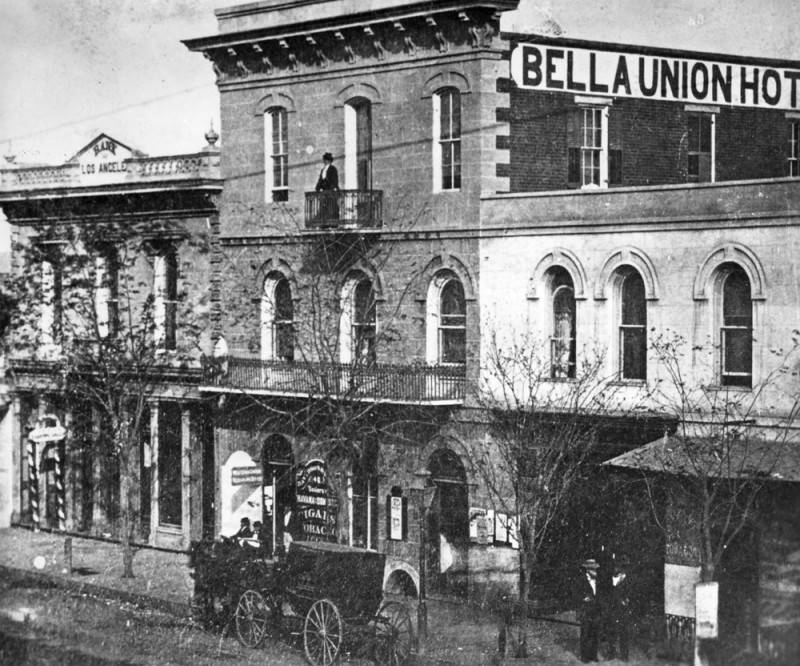

“Daily Life in Early Los Angeles,” a self-guided bicycle tour through nineteenth-century Mexican L.A., is a collaboration between Picturing Mexican America01 https://www.picturingmexicanamerica.com/ (a digital, public humanities project managed by UCLA professor Marissa López) and the Los Angeles Explorers Club02 http://www.laexplorersclub.com/, which organizes bike tours of the city and was founded by Aimee Gilchrist and Brantlea Newbury.
Explorers Club arranges large, group events culminating at a local bar or restaurant where riders can unwind, refuel, and socialize. None of those things were possible in the spring of 2020 as Los Angeles was locked down in a series of COVID-19 quarantines. Cut off from the city, the Explorers Club reached out to Picturing Mexican America in an effort to think differently about Los Angeles. Our inability to go about our daily lives provoked thinking about historic daily life. What did those who moved through this cityscape long before us do for fun? How did early Angelenos entertain themselves, and what do nineteenth-century popular culture and daily life reveal about twenty-first century Los Angeles?
The coronavirus pandemic presented us with an opportunity to show cyclists the Los Angeles of the past—not the cartoon past of Olvera St. and imaginary Spaniards, but the past that’s been built over and erased, that you have to slow down and make an effort to see. The key is to move through space differently than you normally would. You can read about history in books, see it in public monuments, or scroll through it on social media, but we were looking to catalyze physical interaction with city spaces.
Cycling defamiliarizes our sense of space by allowing us to move through the city at different speeds; it amplifies and makes possible what philosopher Henri Bergson refers to as “presence.” To be “present” in space is to experience time as “duration,” apart from chronology. This idea allows Bergson to distinguish between knowledge and sense experience and to develop his theory that an encounter with anything outside our self is a physical transformation that depends on presence and duration.03 Bergson, Henri. Matter and Memory: Essay on the Relation between the Body and the Mind. [1896] Trans. NM Paul and WS Palmer. New York: Zone Books, 1990; Time and Free Will: An Essay on the Data of Immediate Consciousness. [1889] Trans. FL Pogson. London: Dover Publications, 2001; The Creative Mind: An Introduction to Metaphysics. [1934] Mineola, NY: Dover Publications, 2012.
Changing the way we move through the city can shift us away from a conception of time as spatial progression to time as sense, towards Bergson’s duration, where the past can be sensed rather than known. Duration involves “dimensional” experience, according to Bergson, rather than “representational.” He explains this as the difference between walking through a city versus looking at pictures or reading about it. Our tour replaces representation with dimension, offering a transformative experience of the history of Mexican Los Angeles. For us, transformation relies on bikes: specifically, in the case of this project, the bike-share program that the Los Angeles County Metropolitan Transportation Authority, or Metro, launched in 2016.
Metro Bike Share has weathered its fair share of criticism, but our tour imagines bikes—the Metro bikes in particular—as the people’s tool for empowered movement, for an active reclamation of our streets, the importance of which we all saw in summer 2020. We had initially planned to release this ride on June 5, 2020, but by then we had learned about the murders of Ahmaud Arbery, Breonna Taylor, and George Floyd. People in Los Angeles and cities around the country rose up to protest police brutality and anti-Black violence. When the National Guard was called to Los Angeles, we knew it wasn’t the best time to send people out on their bikes. In the end we launched the ride in July; the physical danger had passed, and the ride seemed more important than ever.
The ride is based ion ideas of collective, embodied action, but we’ve designed it as a solitary activity that can be enjoyed alone or together with others. A route map and audio guide are available for download at both the Los Angeles Explorers Club’s and Picturing Mexican America’s websites, along with a GPS enabled ride guide that offers turn-by-turn audio directions.
Riders can listen on their devices (one earbud only, as per California state law!) while learning how nineteenth-century, Mexican LA was neither idyllic, egalitarian, or anti-racist; nevertheless, it’s important to understand that it was here and that the version of California history you might have learned in grade school represents what scholars have described as either a “Fantasy Spanish Heritage” or a “Fantasy Anglo Past.” Whatever you call it, it devalues people of color, depicts them as marginal outsiders, and justifies discrimination and racial violence. Our ride seeks to untangle some of those threads.
